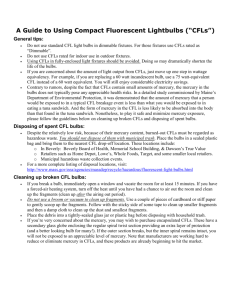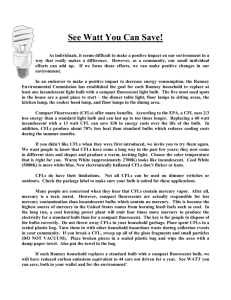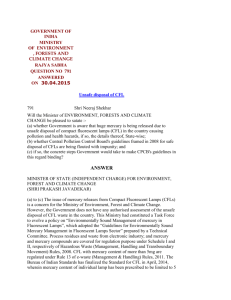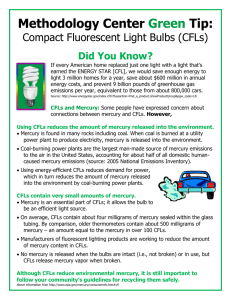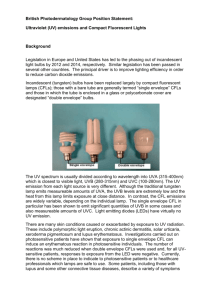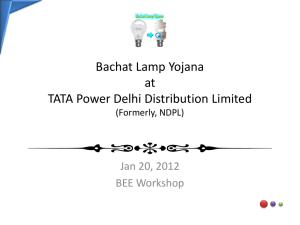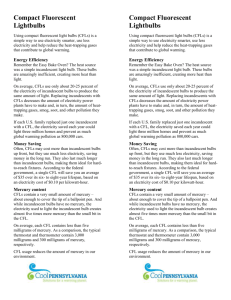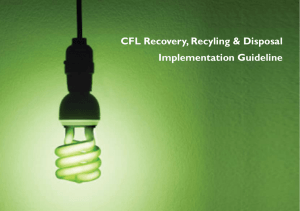Mercury in CFLs - LC policy Jan 08
advertisement
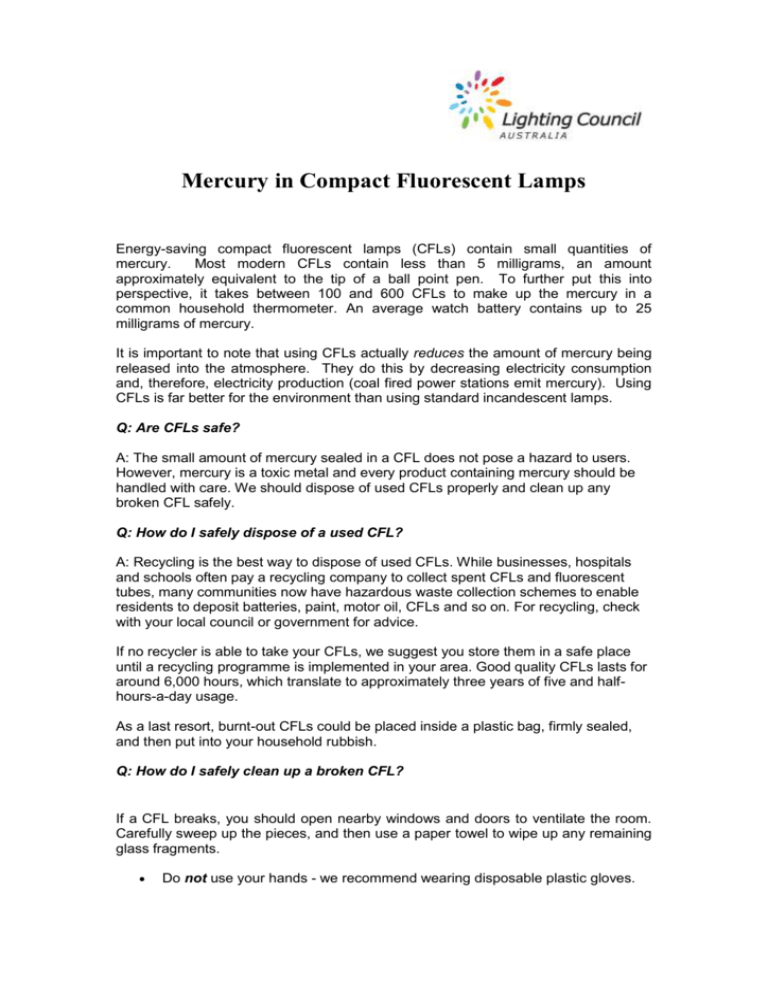
Mercury in Compact Fluorescent Lamps Energy-saving compact fluorescent lamps (CFLs) contain small quantities of mercury. Most modern CFLs contain less than 5 milligrams, an amount approximately equivalent to the tip of a ball point pen. To further put this into perspective, it takes between 100 and 600 CFLs to make up the mercury in a common household thermometer. An average watch battery contains up to 25 milligrams of mercury. It is important to note that using CFLs actually reduces the amount of mercury being released into the atmosphere. They do this by decreasing electricity consumption and, therefore, electricity production (coal fired power stations emit mercury). Using CFLs is far better for the environment than using standard incandescent lamps. Q: Are CFLs safe? A: The small amount of mercury sealed in a CFL does not pose a hazard to users. However, mercury is a toxic metal and every product containing mercury should be handled with care. We should dispose of used CFLs properly and clean up any broken CFL safely. Q: How do I safely dispose of a used CFL? A: Recycling is the best way to dispose of used CFLs. While businesses, hospitals and schools often pay a recycling company to collect spent CFLs and fluorescent tubes, many communities now have hazardous waste collection schemes to enable residents to deposit batteries, paint, motor oil, CFLs and so on. For recycling, check with your local council or government for advice. If no recycler is able to take your CFLs, we suggest you store them in a safe place until a recycling programme is implemented in your area. Good quality CFLs lasts for around 6,000 hours, which translate to approximately three years of five and halfhours-a-day usage. As a last resort, burnt-out CFLs could be placed inside a plastic bag, firmly sealed, and then put into your household rubbish. Q: How do I safely clean up a broken CFL? If a CFL breaks, you should open nearby windows and doors to ventilate the room. Carefully sweep up the pieces, and then use a paper towel to wipe up any remaining glass fragments. Do not use your hands - we recommend wearing disposable plastic gloves. 2 Do not use a vacuum cleaner, which can trap or spread the mercury in the house. Seal the pieces, plastic gloves and paper towel in a plastic bag for safe disposal. Q: Does using CFLs contribute to mercury pollution? A: Using energy-saving CFLs actually reduces the amount of mercury released into the atmosphere, where it most affects our health. How? Most mercury in the air comes from burning fossil fuels to generate electricity. CFLs use 80% less energy than a standard incandescent bulb, reducing the need for electricity production. CFLs thus help to reduce mercury emissions, as well as carbon dioxide and greenhouse gas emissions. Q: Will the proposed phase-out of inefficient light bulbs and the expected increased usage of CFLs cause an increase in mercury emissions? The National Pollutant Inventory reported that Australia’s total annual emissions of mercury in 2005/06 were 28,000 kg. It has been estimated that emissions from all lamps (not just CFLs) constitute just 1.7% of this figure. The increased use of CFLs brought about by the phase-out of incandescent globes will add an additional 0.19% to this figure. Hence the proportion of mercury released to the environment as a consequence of the phase-out is small compared to total emissions. However, as noted above, the increased use of CFLs will lead to a net reduction of mercury emissions because of reduced reliance on energy from coal-fired power stations. Q: Is there an alternative to CFLs? A: Lighting Council Australia members are now working to develop LED (lightemitting diode) technology as a practical CFL alternative. LEDs, which have been used in electronics for decades, convert 90% of the incoming electrical charge into a luminous energy and use only one-eighth of the power of traditional bulbs and less than half that for CFLs. They also last a very long time - up to 50,000 hours
